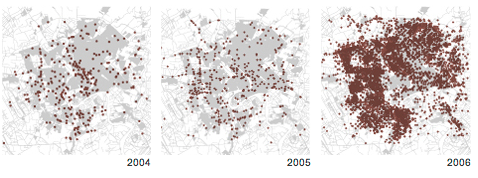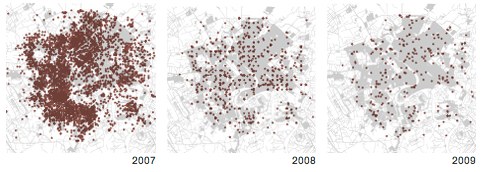This past Friday, Wikileaks released a second batch of reports on Iraq:
At 5pm EST Friday 22nd October 2010 WikiLeaks released the largest classified military leak in history. The 391,832 reports (‘The Iraq War Logs’), document the war and occupation in Iraq, from 1st January 2004 to 31st December 2009 (except for the months of May 2004 and March 2009) as told by soldiers in the United States Army. Each is a ‘SIGACT’ or Significant Action in the war. They detail events as seen and heard by the US military troops on the ground in Iraq and are the first real glimpse into the secret history of the war that the United States government has been privy to throughout.
The New York Times has reported the data in dept with a series of maps, along with a number of articles. One maps shows one of the deadliest days in 2006 in Baghdad, when there were a reported 114 episodes of violence (above).
Below shows a wideout view, annually. As you can see, 2006 and 2007 were especially active.


The Guardian Datablog also has a rougher map via Google Maps along with processed data for download.


 Visualize This: The FlowingData Guide to Design, Visualization, and Statistics (2nd Edition)
Visualize This: The FlowingData Guide to Design, Visualization, and Statistics (2nd Edition)

Hi Nathan
There are a few more examples of the wikileaks-related visualisations here: http://www.visualisingdata.com/index.php/2010/10/iraq-war-logs-released-by-wikileaks/
Some of them a great, others bring little added value.
Cheers
Andy
Geography shows again that it can be helpful to see an activity in space. Great.
In addition, it would facilitate understanding if the activity map were overelayed with a map with the political, social, ethnic, religious, military, etc. characteristics of the neighbourhoods.
– Does a concentration of military & police posts explain a focus of the attacks ?
– Is it a high population density of shiites ?
– Or the location of the homes of specific political leaders, and their offices ?
– Or just the location of mosques or public markets to increase carnage ?
The mere spatial distribution of activities (here : attacks) is just a (helpful) description, but it explains nothing.